SH7007 Inter-Professional Practice: Commentary & Practice Report
VerifiedAdded on 2023/06/04
|14
|4272
|172
Report
AI Summary
This report provides a reflective commentary and analysis of inter-professional practice within health and social care settings. Part A offers a personal reflection on team dynamics, communication, and empathy during a case conference, referencing Tuckman’s theory and the importance of listening skills. Part B critically reviews the opportunities and challenges of inter-professional collaboration (IPC) in clinical practice, research, and education, highlighting benefits such as improved patient outcomes and efficiency. The report also discusses relevant policies and legislation promoting IPC, like the Mental Health Act 2007, and concludes with the growing significance of IPCP in addressing healthcare disparities. Desklib offers a platform where students can access similar solved assignments and study resources.
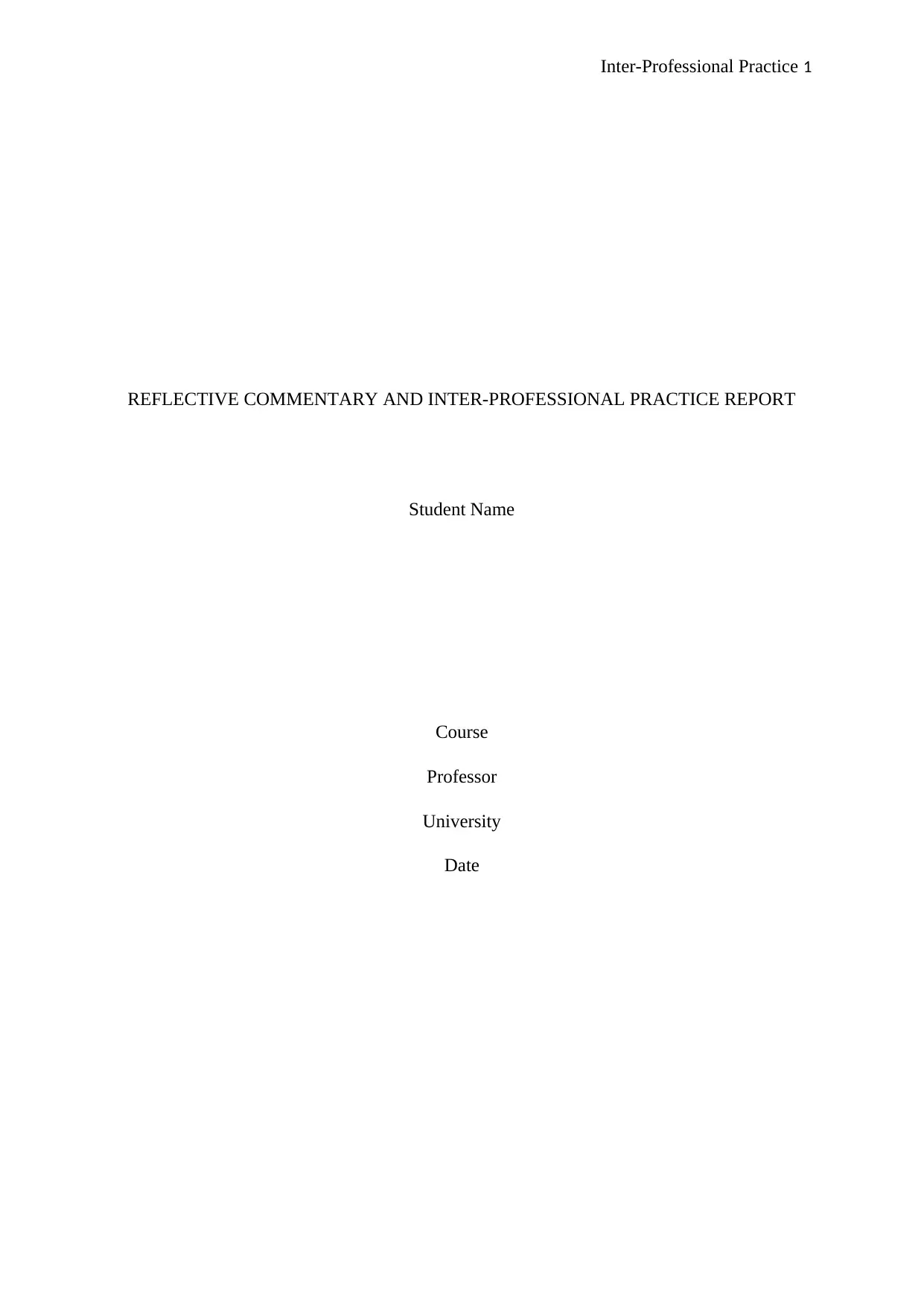
Inter-Professional Practice 1
REFLECTIVE COMMENTARY AND INTER-PROFESSIONAL PRACTICE REPORT
Student Name
Course
Professor
University
Date
REFLECTIVE COMMENTARY AND INTER-PROFESSIONAL PRACTICE REPORT
Student Name
Course
Professor
University
Date
Paraphrase This Document
Need a fresh take? Get an instant paraphrase of this document with our AI Paraphraser
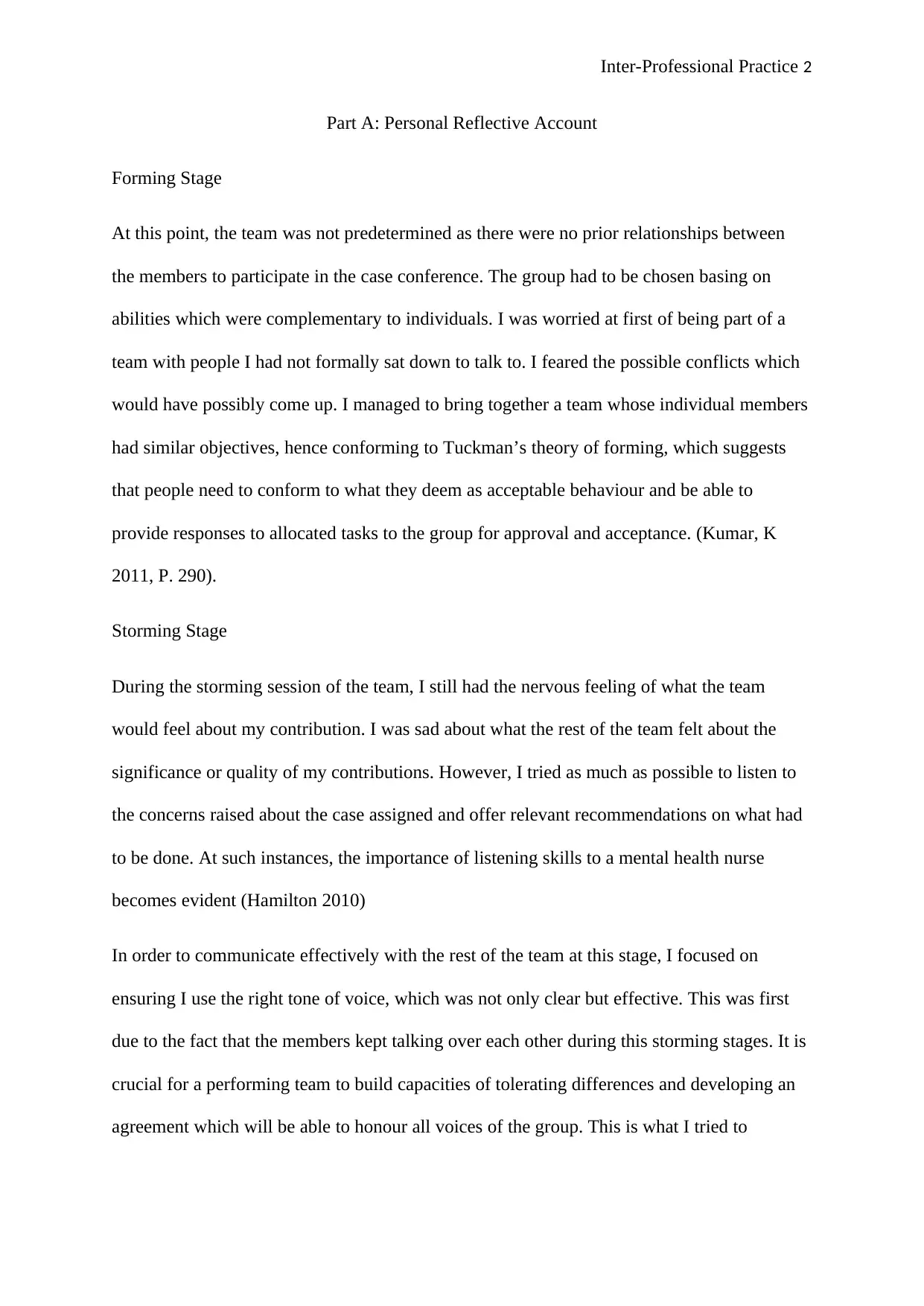
Inter-Professional Practice 2
Part A: Personal Reflective Account
Forming Stage
At this point, the team was not predetermined as there were no prior relationships between
the members to participate in the case conference. The group had to be chosen basing on
abilities which were complementary to individuals. I was worried at first of being part of a
team with people I had not formally sat down to talk to. I feared the possible conflicts which
would have possibly come up. I managed to bring together a team whose individual members
had similar objectives, hence conforming to Tuckman’s theory of forming, which suggests
that people need to conform to what they deem as acceptable behaviour and be able to
provide responses to allocated tasks to the group for approval and acceptance. (Kumar, K
2011, P. 290).
Storming Stage
During the storming session of the team, I still had the nervous feeling of what the team
would feel about my contribution. I was sad about what the rest of the team felt about the
significance or quality of my contributions. However, I tried as much as possible to listen to
the concerns raised about the case assigned and offer relevant recommendations on what had
to be done. At such instances, the importance of listening skills to a mental health nurse
becomes evident (Hamilton 2010)
In order to communicate effectively with the rest of the team at this stage, I focused on
ensuring I use the right tone of voice, which was not only clear but effective. This was first
due to the fact that the members kept talking over each other during this storming stages. It is
crucial for a performing team to build capacities of tolerating differences and developing an
agreement which will be able to honour all voices of the group. This is what I tried to
Part A: Personal Reflective Account
Forming Stage
At this point, the team was not predetermined as there were no prior relationships between
the members to participate in the case conference. The group had to be chosen basing on
abilities which were complementary to individuals. I was worried at first of being part of a
team with people I had not formally sat down to talk to. I feared the possible conflicts which
would have possibly come up. I managed to bring together a team whose individual members
had similar objectives, hence conforming to Tuckman’s theory of forming, which suggests
that people need to conform to what they deem as acceptable behaviour and be able to
provide responses to allocated tasks to the group for approval and acceptance. (Kumar, K
2011, P. 290).
Storming Stage
During the storming session of the team, I still had the nervous feeling of what the team
would feel about my contribution. I was sad about what the rest of the team felt about the
significance or quality of my contributions. However, I tried as much as possible to listen to
the concerns raised about the case assigned and offer relevant recommendations on what had
to be done. At such instances, the importance of listening skills to a mental health nurse
becomes evident (Hamilton 2010)
In order to communicate effectively with the rest of the team at this stage, I focused on
ensuring I use the right tone of voice, which was not only clear but effective. This was first
due to the fact that the members kept talking over each other during this storming stages. It is
crucial for a performing team to build capacities of tolerating differences and developing an
agreement which will be able to honour all voices of the group. This is what I tried to
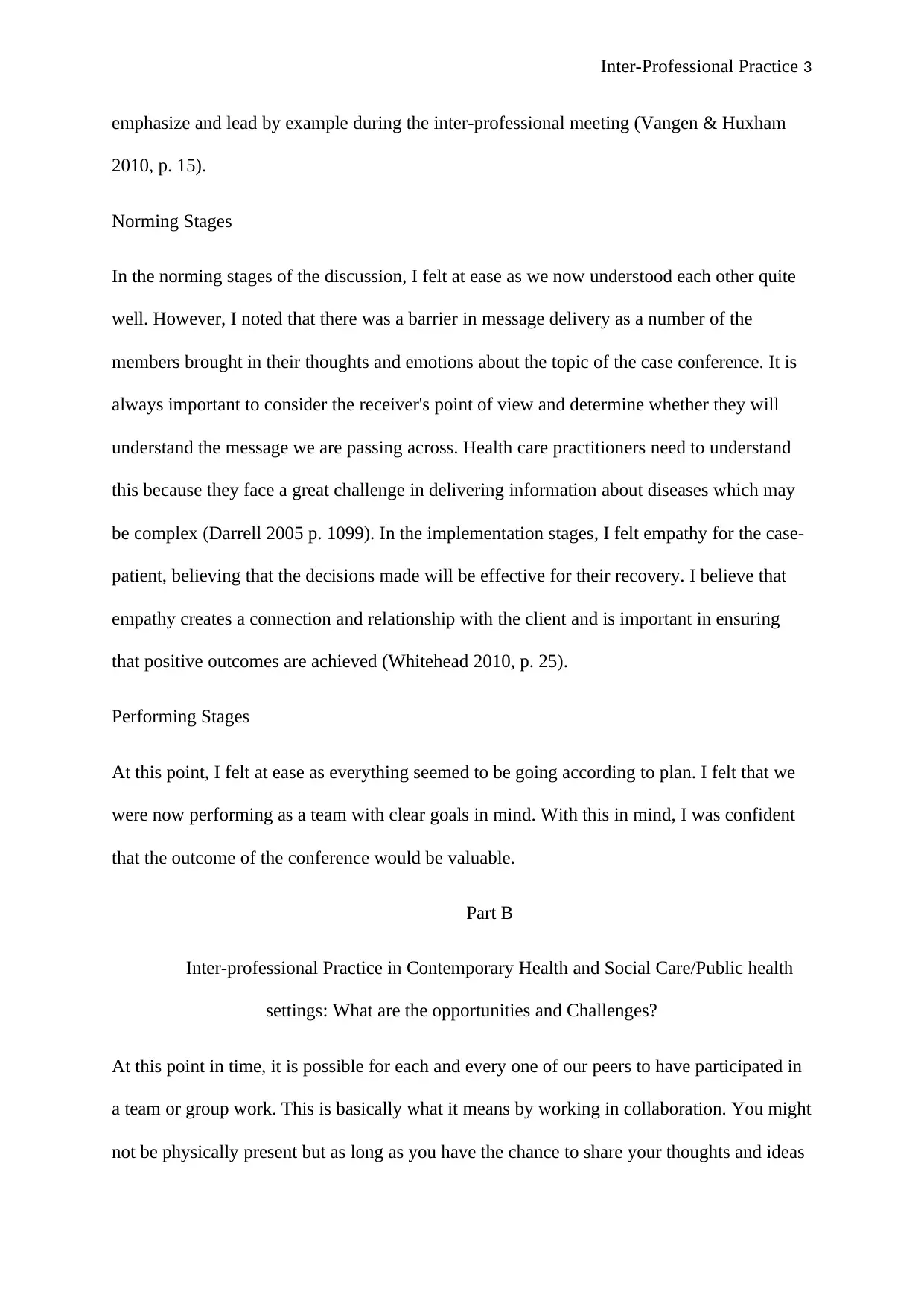
Inter-Professional Practice 3
emphasize and lead by example during the inter-professional meeting (Vangen & Huxham
2010, p. 15).
Norming Stages
In the norming stages of the discussion, I felt at ease as we now understood each other quite
well. However, I noted that there was a barrier in message delivery as a number of the
members brought in their thoughts and emotions about the topic of the case conference. It is
always important to consider the receiver's point of view and determine whether they will
understand the message we are passing across. Health care practitioners need to understand
this because they face a great challenge in delivering information about diseases which may
be complex (Darrell 2005 p. 1099). In the implementation stages, I felt empathy for the case-
patient, believing that the decisions made will be effective for their recovery. I believe that
empathy creates a connection and relationship with the client and is important in ensuring
that positive outcomes are achieved (Whitehead 2010, p. 25).
Performing Stages
At this point, I felt at ease as everything seemed to be going according to plan. I felt that we
were now performing as a team with clear goals in mind. With this in mind, I was confident
that the outcome of the conference would be valuable.
Part B
Inter-professional Practice in Contemporary Health and Social Care/Public health
settings: What are the opportunities and Challenges?
At this point in time, it is possible for each and every one of our peers to have participated in
a team or group work. This is basically what it means by working in collaboration. You might
not be physically present but as long as you have the chance to share your thoughts and ideas
emphasize and lead by example during the inter-professional meeting (Vangen & Huxham
2010, p. 15).
Norming Stages
In the norming stages of the discussion, I felt at ease as we now understood each other quite
well. However, I noted that there was a barrier in message delivery as a number of the
members brought in their thoughts and emotions about the topic of the case conference. It is
always important to consider the receiver's point of view and determine whether they will
understand the message we are passing across. Health care practitioners need to understand
this because they face a great challenge in delivering information about diseases which may
be complex (Darrell 2005 p. 1099). In the implementation stages, I felt empathy for the case-
patient, believing that the decisions made will be effective for their recovery. I believe that
empathy creates a connection and relationship with the client and is important in ensuring
that positive outcomes are achieved (Whitehead 2010, p. 25).
Performing Stages
At this point, I felt at ease as everything seemed to be going according to plan. I felt that we
were now performing as a team with clear goals in mind. With this in mind, I was confident
that the outcome of the conference would be valuable.
Part B
Inter-professional Practice in Contemporary Health and Social Care/Public health
settings: What are the opportunities and Challenges?
At this point in time, it is possible for each and every one of our peers to have participated in
a team or group work. This is basically what it means by working in collaboration. You might
not be physically present but as long as you have the chance to share your thoughts and ideas
⊘ This is a preview!⊘
Do you want full access?
Subscribe today to unlock all pages.

Trusted by 1+ million students worldwide
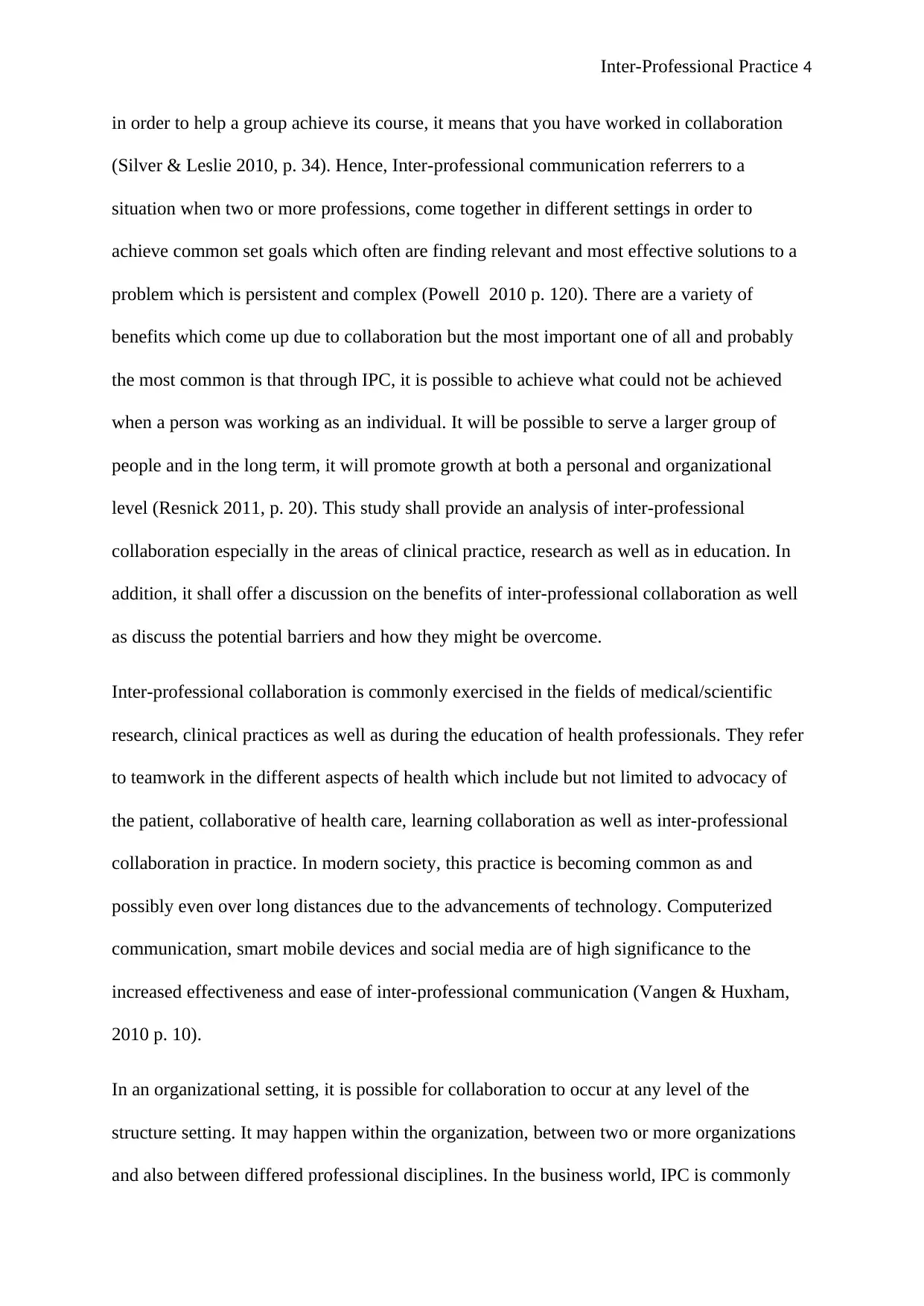
Inter-Professional Practice 4
in order to help a group achieve its course, it means that you have worked in collaboration
(Silver & Leslie 2010, p. 34). Hence, Inter-professional communication referrers to a
situation when two or more professions, come together in different settings in order to
achieve common set goals which often are finding relevant and most effective solutions to a
problem which is persistent and complex (Powell 2010 p. 120). There are a variety of
benefits which come up due to collaboration but the most important one of all and probably
the most common is that through IPC, it is possible to achieve what could not be achieved
when a person was working as an individual. It will be possible to serve a larger group of
people and in the long term, it will promote growth at both a personal and organizational
level (Resnick 2011, p. 20). This study shall provide an analysis of inter-professional
collaboration especially in the areas of clinical practice, research as well as in education. In
addition, it shall offer a discussion on the benefits of inter-professional collaboration as well
as discuss the potential barriers and how they might be overcome.
Inter-professional collaboration is commonly exercised in the fields of medical/scientific
research, clinical practices as well as during the education of health professionals. They refer
to teamwork in the different aspects of health which include but not limited to advocacy of
the patient, collaborative of health care, learning collaboration as well as inter-professional
collaboration in practice. In modern society, this practice is becoming common as and
possibly even over long distances due to the advancements of technology. Computerized
communication, smart mobile devices and social media are of high significance to the
increased effectiveness and ease of inter-professional communication (Vangen & Huxham,
2010 p. 10).
In an organizational setting, it is possible for collaboration to occur at any level of the
structure setting. It may happen within the organization, between two or more organizations
and also between differed professional disciplines. In the business world, IPC is commonly
in order to help a group achieve its course, it means that you have worked in collaboration
(Silver & Leslie 2010, p. 34). Hence, Inter-professional communication referrers to a
situation when two or more professions, come together in different settings in order to
achieve common set goals which often are finding relevant and most effective solutions to a
problem which is persistent and complex (Powell 2010 p. 120). There are a variety of
benefits which come up due to collaboration but the most important one of all and probably
the most common is that through IPC, it is possible to achieve what could not be achieved
when a person was working as an individual. It will be possible to serve a larger group of
people and in the long term, it will promote growth at both a personal and organizational
level (Resnick 2011, p. 20). This study shall provide an analysis of inter-professional
collaboration especially in the areas of clinical practice, research as well as in education. In
addition, it shall offer a discussion on the benefits of inter-professional collaboration as well
as discuss the potential barriers and how they might be overcome.
Inter-professional collaboration is commonly exercised in the fields of medical/scientific
research, clinical practices as well as during the education of health professionals. They refer
to teamwork in the different aspects of health which include but not limited to advocacy of
the patient, collaborative of health care, learning collaboration as well as inter-professional
collaboration in practice. In modern society, this practice is becoming common as and
possibly even over long distances due to the advancements of technology. Computerized
communication, smart mobile devices and social media are of high significance to the
increased effectiveness and ease of inter-professional communication (Vangen & Huxham,
2010 p. 10).
In an organizational setting, it is possible for collaboration to occur at any level of the
structure setting. It may happen within the organization, between two or more organizations
and also between differed professional disciplines. In the business world, IPC is commonly
Paraphrase This Document
Need a fresh take? Get an instant paraphrase of this document with our AI Paraphraser
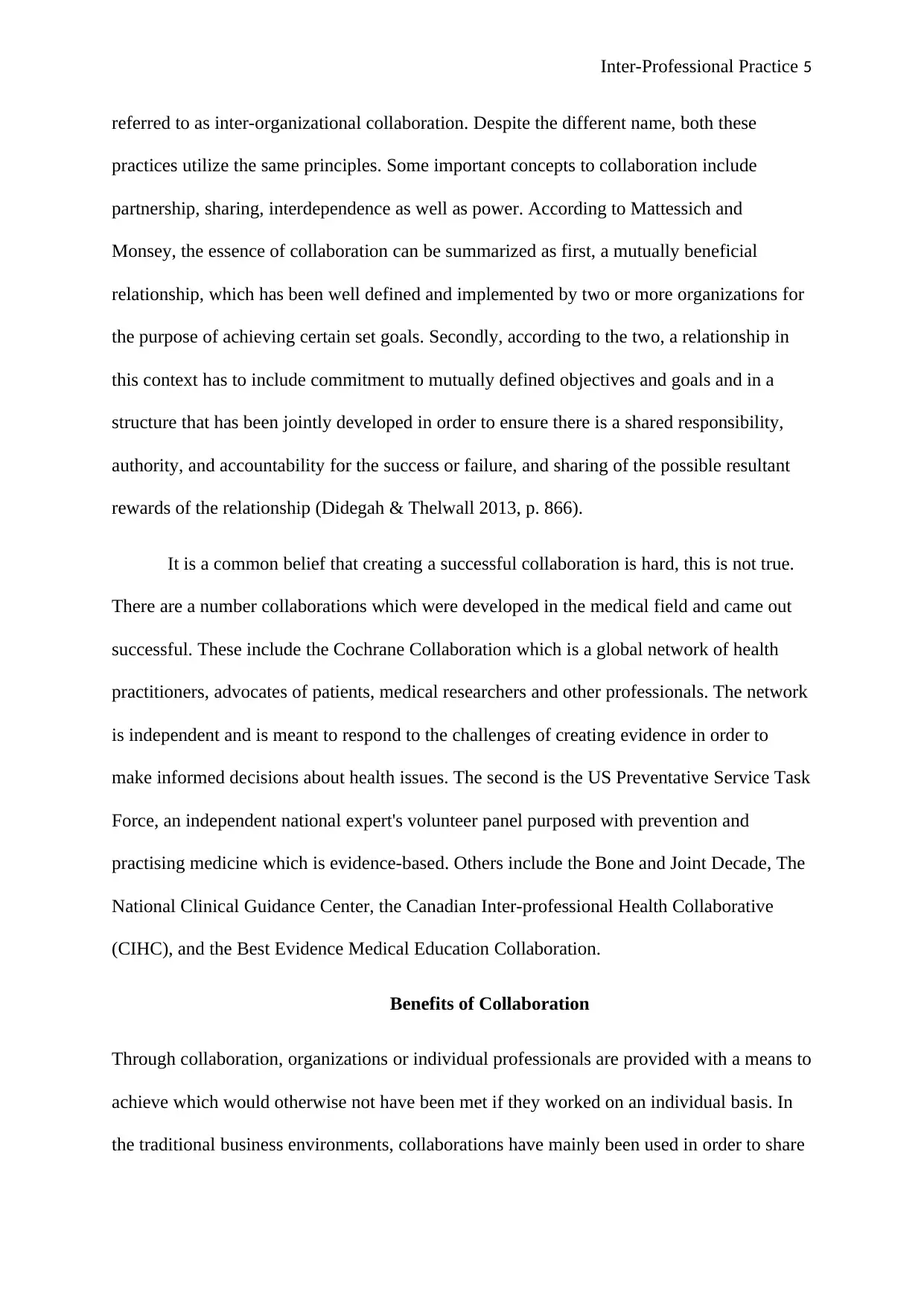
Inter-Professional Practice 5
referred to as inter-organizational collaboration. Despite the different name, both these
practices utilize the same principles. Some important concepts to collaboration include
partnership, sharing, interdependence as well as power. According to Mattessich and
Monsey, the essence of collaboration can be summarized as first, a mutually beneficial
relationship, which has been well defined and implemented by two or more organizations for
the purpose of achieving certain set goals. Secondly, according to the two, a relationship in
this context has to include commitment to mutually defined objectives and goals and in a
structure that has been jointly developed in order to ensure there is a shared responsibility,
authority, and accountability for the success or failure, and sharing of the possible resultant
rewards of the relationship (Didegah & Thelwall 2013, p. 866).
It is a common belief that creating a successful collaboration is hard, this is not true.
There are a number collaborations which were developed in the medical field and came out
successful. These include the Cochrane Collaboration which is a global network of health
practitioners, advocates of patients, medical researchers and other professionals. The network
is independent and is meant to respond to the challenges of creating evidence in order to
make informed decisions about health issues. The second is the US Preventative Service Task
Force, an independent national expert's volunteer panel purposed with prevention and
practising medicine which is evidence-based. Others include the Bone and Joint Decade, The
National Clinical Guidance Center, the Canadian Inter-professional Health Collaborative
(CIHC), and the Best Evidence Medical Education Collaboration.
Benefits of Collaboration
Through collaboration, organizations or individual professionals are provided with a means to
achieve which would otherwise not have been met if they worked on an individual basis. In
the traditional business environments, collaborations have mainly been used in order to share
referred to as inter-organizational collaboration. Despite the different name, both these
practices utilize the same principles. Some important concepts to collaboration include
partnership, sharing, interdependence as well as power. According to Mattessich and
Monsey, the essence of collaboration can be summarized as first, a mutually beneficial
relationship, which has been well defined and implemented by two or more organizations for
the purpose of achieving certain set goals. Secondly, according to the two, a relationship in
this context has to include commitment to mutually defined objectives and goals and in a
structure that has been jointly developed in order to ensure there is a shared responsibility,
authority, and accountability for the success or failure, and sharing of the possible resultant
rewards of the relationship (Didegah & Thelwall 2013, p. 866).
It is a common belief that creating a successful collaboration is hard, this is not true.
There are a number collaborations which were developed in the medical field and came out
successful. These include the Cochrane Collaboration which is a global network of health
practitioners, advocates of patients, medical researchers and other professionals. The network
is independent and is meant to respond to the challenges of creating evidence in order to
make informed decisions about health issues. The second is the US Preventative Service Task
Force, an independent national expert's volunteer panel purposed with prevention and
practising medicine which is evidence-based. Others include the Bone and Joint Decade, The
National Clinical Guidance Center, the Canadian Inter-professional Health Collaborative
(CIHC), and the Best Evidence Medical Education Collaboration.
Benefits of Collaboration
Through collaboration, organizations or individual professionals are provided with a means to
achieve which would otherwise not have been met if they worked on an individual basis. In
the traditional business environments, collaborations have mainly been used in order to share
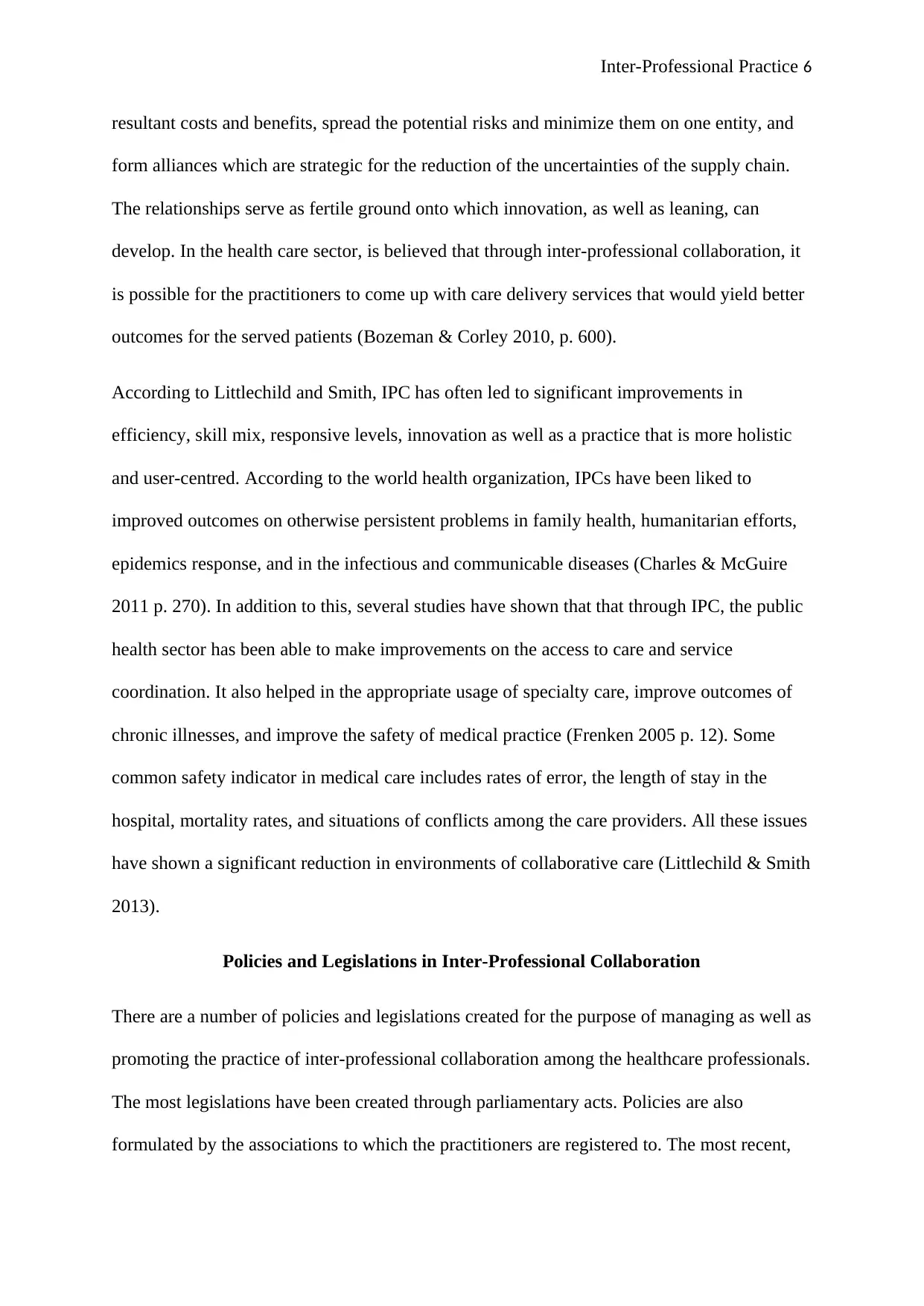
Inter-Professional Practice 6
resultant costs and benefits, spread the potential risks and minimize them on one entity, and
form alliances which are strategic for the reduction of the uncertainties of the supply chain.
The relationships serve as fertile ground onto which innovation, as well as leaning, can
develop. In the health care sector, is believed that through inter-professional collaboration, it
is possible for the practitioners to come up with care delivery services that would yield better
outcomes for the served patients (Bozeman & Corley 2010, p. 600).
According to Littlechild and Smith, IPC has often led to significant improvements in
efficiency, skill mix, responsive levels, innovation as well as a practice that is more holistic
and user-centred. According to the world health organization, IPCs have been liked to
improved outcomes on otherwise persistent problems in family health, humanitarian efforts,
epidemics response, and in the infectious and communicable diseases (Charles & McGuire
2011 p. 270). In addition to this, several studies have shown that that through IPC, the public
health sector has been able to make improvements on the access to care and service
coordination. It also helped in the appropriate usage of specialty care, improve outcomes of
chronic illnesses, and improve the safety of medical practice (Frenken 2005 p. 12). Some
common safety indicator in medical care includes rates of error, the length of stay in the
hospital, mortality rates, and situations of conflicts among the care providers. All these issues
have shown a significant reduction in environments of collaborative care (Littlechild & Smith
2013).
Policies and Legislations in Inter-Professional Collaboration
There are a number of policies and legislations created for the purpose of managing as well as
promoting the practice of inter-professional collaboration among the healthcare professionals.
The most legislations have been created through parliamentary acts. Policies are also
formulated by the associations to which the practitioners are registered to. The most recent,
resultant costs and benefits, spread the potential risks and minimize them on one entity, and
form alliances which are strategic for the reduction of the uncertainties of the supply chain.
The relationships serve as fertile ground onto which innovation, as well as leaning, can
develop. In the health care sector, is believed that through inter-professional collaboration, it
is possible for the practitioners to come up with care delivery services that would yield better
outcomes for the served patients (Bozeman & Corley 2010, p. 600).
According to Littlechild and Smith, IPC has often led to significant improvements in
efficiency, skill mix, responsive levels, innovation as well as a practice that is more holistic
and user-centred. According to the world health organization, IPCs have been liked to
improved outcomes on otherwise persistent problems in family health, humanitarian efforts,
epidemics response, and in the infectious and communicable diseases (Charles & McGuire
2011 p. 270). In addition to this, several studies have shown that that through IPC, the public
health sector has been able to make improvements on the access to care and service
coordination. It also helped in the appropriate usage of specialty care, improve outcomes of
chronic illnesses, and improve the safety of medical practice (Frenken 2005 p. 12). Some
common safety indicator in medical care includes rates of error, the length of stay in the
hospital, mortality rates, and situations of conflicts among the care providers. All these issues
have shown a significant reduction in environments of collaborative care (Littlechild & Smith
2013).
Policies and Legislations in Inter-Professional Collaboration
There are a number of policies and legislations created for the purpose of managing as well as
promoting the practice of inter-professional collaboration among the healthcare professionals.
The most legislations have been created through parliamentary acts. Policies are also
formulated by the associations to which the practitioners are registered to. The most recent,
⊘ This is a preview!⊘
Do you want full access?
Subscribe today to unlock all pages.

Trusted by 1+ million students worldwide
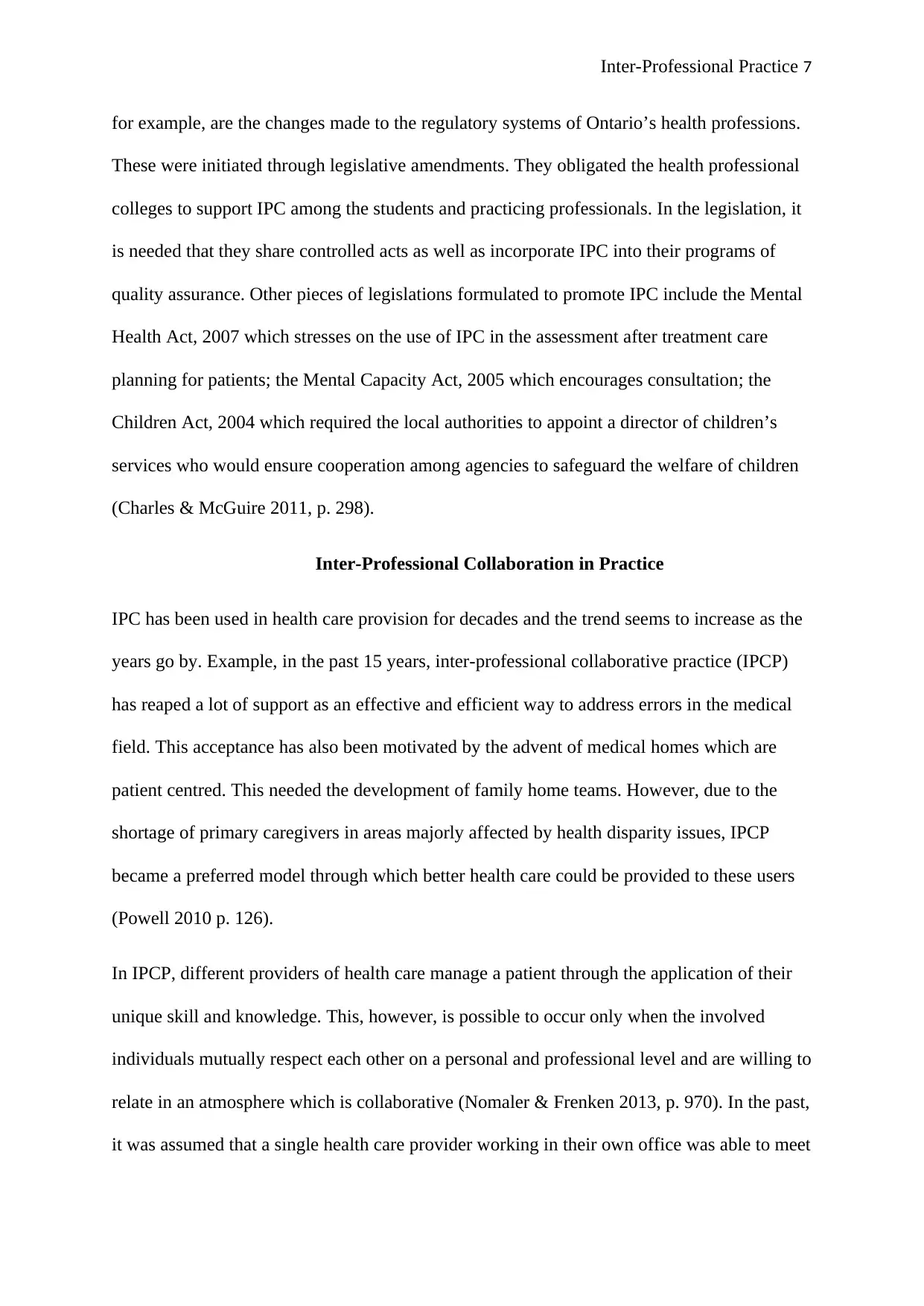
Inter-Professional Practice 7
for example, are the changes made to the regulatory systems of Ontario’s health professions.
These were initiated through legislative amendments. They obligated the health professional
colleges to support IPC among the students and practicing professionals. In the legislation, it
is needed that they share controlled acts as well as incorporate IPC into their programs of
quality assurance. Other pieces of legislations formulated to promote IPC include the Mental
Health Act, 2007 which stresses on the use of IPC in the assessment after treatment care
planning for patients; the Mental Capacity Act, 2005 which encourages consultation; the
Children Act, 2004 which required the local authorities to appoint a director of children’s
services who would ensure cooperation among agencies to safeguard the welfare of children
(Charles & McGuire 2011, p. 298).
Inter-Professional Collaboration in Practice
IPC has been used in health care provision for decades and the trend seems to increase as the
years go by. Example, in the past 15 years, inter-professional collaborative practice (IPCP)
has reaped a lot of support as an effective and efficient way to address errors in the medical
field. This acceptance has also been motivated by the advent of medical homes which are
patient centred. This needed the development of family home teams. However, due to the
shortage of primary caregivers in areas majorly affected by health disparity issues, IPCP
became a preferred model through which better health care could be provided to these users
(Powell 2010 p. 126).
In IPCP, different providers of health care manage a patient through the application of their
unique skill and knowledge. This, however, is possible to occur only when the involved
individuals mutually respect each other on a personal and professional level and are willing to
relate in an atmosphere which is collaborative (Nomaler & Frenken 2013, p. 970). In the past,
it was assumed that a single health care provider working in their own office was able to meet
for example, are the changes made to the regulatory systems of Ontario’s health professions.
These were initiated through legislative amendments. They obligated the health professional
colleges to support IPC among the students and practicing professionals. In the legislation, it
is needed that they share controlled acts as well as incorporate IPC into their programs of
quality assurance. Other pieces of legislations formulated to promote IPC include the Mental
Health Act, 2007 which stresses on the use of IPC in the assessment after treatment care
planning for patients; the Mental Capacity Act, 2005 which encourages consultation; the
Children Act, 2004 which required the local authorities to appoint a director of children’s
services who would ensure cooperation among agencies to safeguard the welfare of children
(Charles & McGuire 2011, p. 298).
Inter-Professional Collaboration in Practice
IPC has been used in health care provision for decades and the trend seems to increase as the
years go by. Example, in the past 15 years, inter-professional collaborative practice (IPCP)
has reaped a lot of support as an effective and efficient way to address errors in the medical
field. This acceptance has also been motivated by the advent of medical homes which are
patient centred. This needed the development of family home teams. However, due to the
shortage of primary caregivers in areas majorly affected by health disparity issues, IPCP
became a preferred model through which better health care could be provided to these users
(Powell 2010 p. 126).
In IPCP, different providers of health care manage a patient through the application of their
unique skill and knowledge. This, however, is possible to occur only when the involved
individuals mutually respect each other on a personal and professional level and are willing to
relate in an atmosphere which is collaborative (Nomaler & Frenken 2013, p. 970). In the past,
it was assumed that a single health care provider working in their own office was able to meet
Paraphrase This Document
Need a fresh take? Get an instant paraphrase of this document with our AI Paraphraser
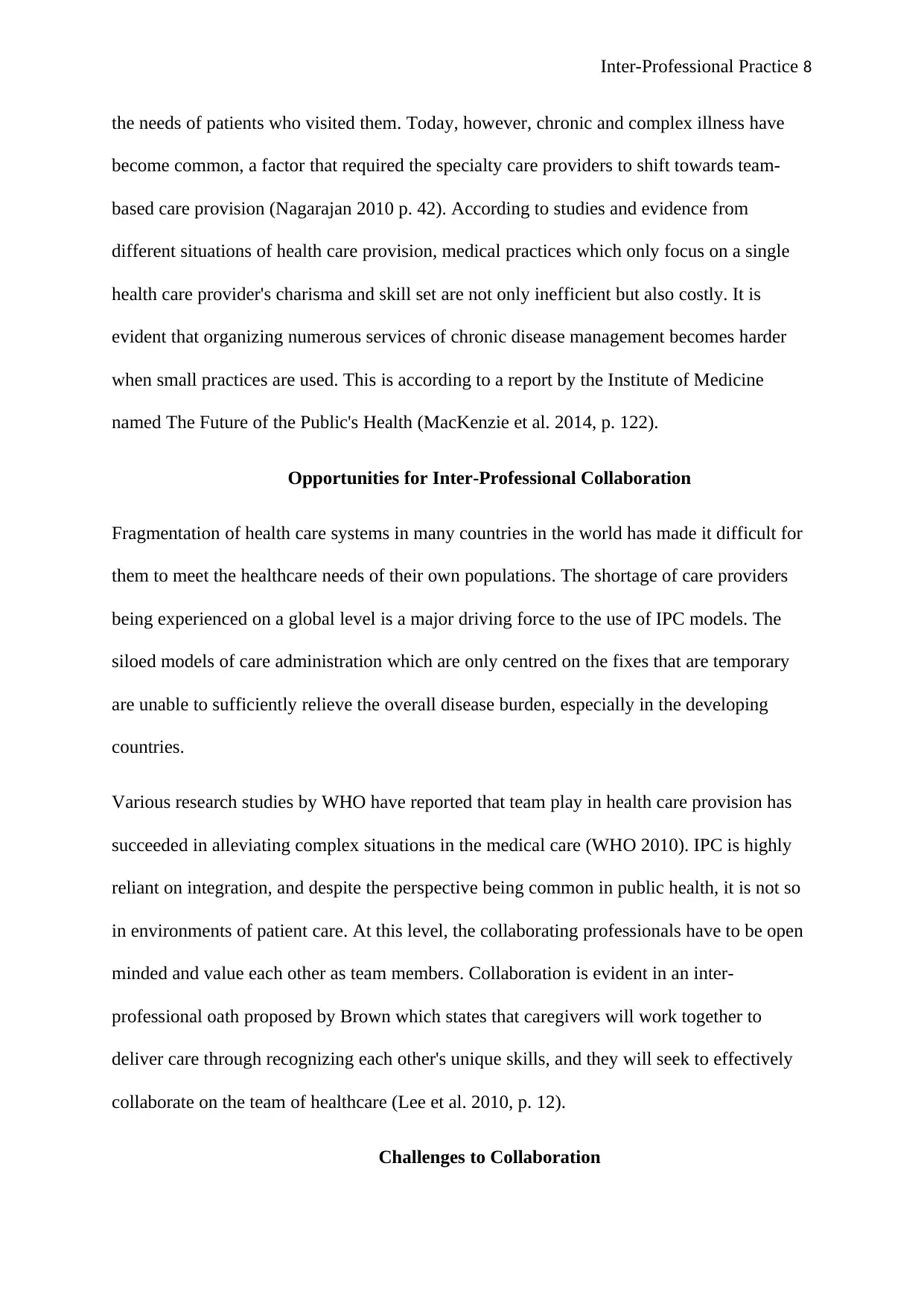
Inter-Professional Practice 8
the needs of patients who visited them. Today, however, chronic and complex illness have
become common, a factor that required the specialty care providers to shift towards team-
based care provision (Nagarajan 2010 p. 42). According to studies and evidence from
different situations of health care provision, medical practices which only focus on a single
health care provider's charisma and skill set are not only inefficient but also costly. It is
evident that organizing numerous services of chronic disease management becomes harder
when small practices are used. This is according to a report by the Institute of Medicine
named The Future of the Public's Health (MacKenzie et al. 2014, p. 122).
Opportunities for Inter-Professional Collaboration
Fragmentation of health care systems in many countries in the world has made it difficult for
them to meet the healthcare needs of their own populations. The shortage of care providers
being experienced on a global level is a major driving force to the use of IPC models. The
siloed models of care administration which are only centred on the fixes that are temporary
are unable to sufficiently relieve the overall disease burden, especially in the developing
countries.
Various research studies by WHO have reported that team play in health care provision has
succeeded in alleviating complex situations in the medical care (WHO 2010). IPC is highly
reliant on integration, and despite the perspective being common in public health, it is not so
in environments of patient care. At this level, the collaborating professionals have to be open
minded and value each other as team members. Collaboration is evident in an inter-
professional oath proposed by Brown which states that caregivers will work together to
deliver care through recognizing each other's unique skills, and they will seek to effectively
collaborate on the team of healthcare (Lee et al. 2010, p. 12).
Challenges to Collaboration
the needs of patients who visited them. Today, however, chronic and complex illness have
become common, a factor that required the specialty care providers to shift towards team-
based care provision (Nagarajan 2010 p. 42). According to studies and evidence from
different situations of health care provision, medical practices which only focus on a single
health care provider's charisma and skill set are not only inefficient but also costly. It is
evident that organizing numerous services of chronic disease management becomes harder
when small practices are used. This is according to a report by the Institute of Medicine
named The Future of the Public's Health (MacKenzie et al. 2014, p. 122).
Opportunities for Inter-Professional Collaboration
Fragmentation of health care systems in many countries in the world has made it difficult for
them to meet the healthcare needs of their own populations. The shortage of care providers
being experienced on a global level is a major driving force to the use of IPC models. The
siloed models of care administration which are only centred on the fixes that are temporary
are unable to sufficiently relieve the overall disease burden, especially in the developing
countries.
Various research studies by WHO have reported that team play in health care provision has
succeeded in alleviating complex situations in the medical care (WHO 2010). IPC is highly
reliant on integration, and despite the perspective being common in public health, it is not so
in environments of patient care. At this level, the collaborating professionals have to be open
minded and value each other as team members. Collaboration is evident in an inter-
professional oath proposed by Brown which states that caregivers will work together to
deliver care through recognizing each other's unique skills, and they will seek to effectively
collaborate on the team of healthcare (Lee et al. 2010, p. 12).
Challenges to Collaboration
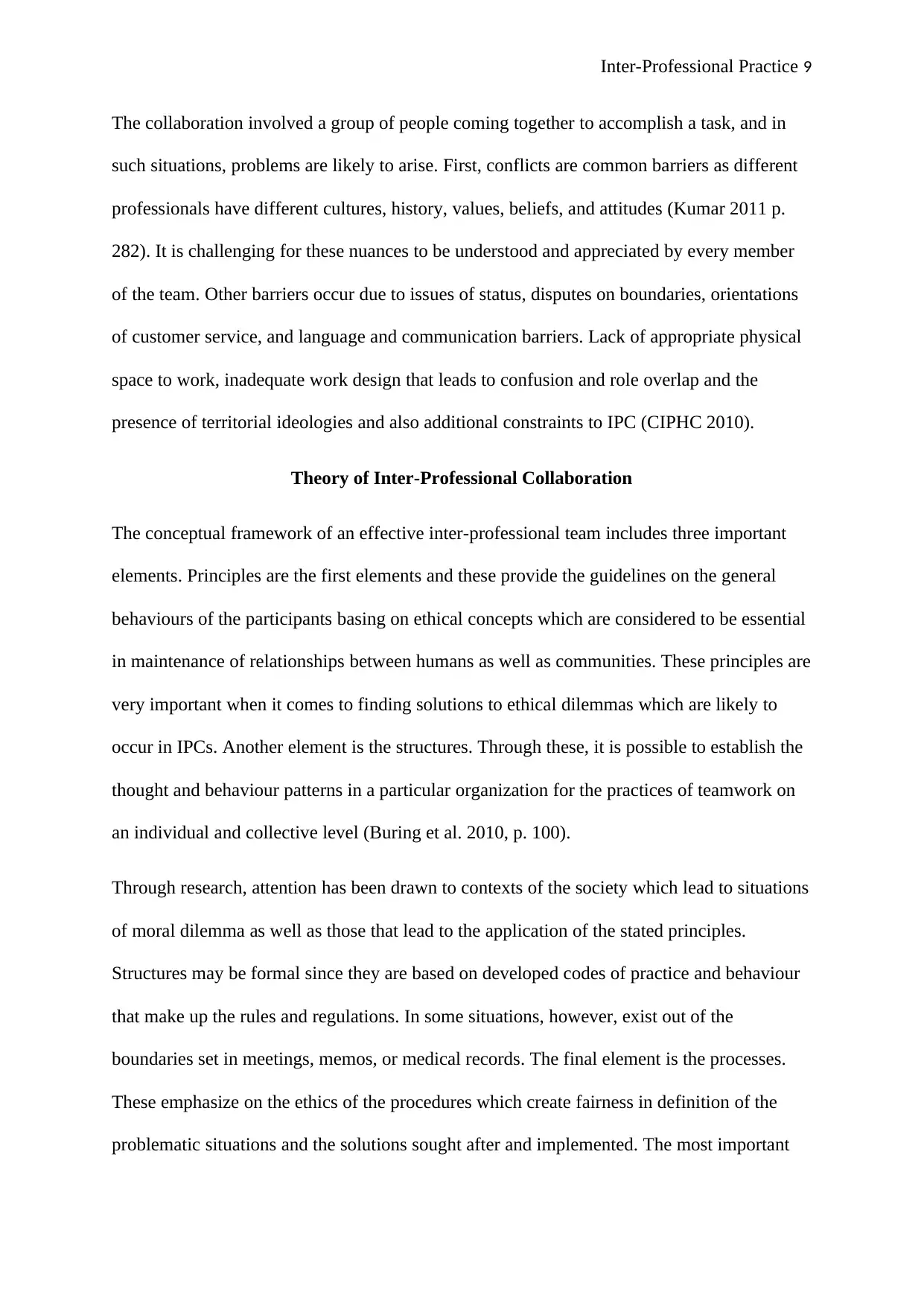
Inter-Professional Practice 9
The collaboration involved a group of people coming together to accomplish a task, and in
such situations, problems are likely to arise. First, conflicts are common barriers as different
professionals have different cultures, history, values, beliefs, and attitudes (Kumar 2011 p.
282). It is challenging for these nuances to be understood and appreciated by every member
of the team. Other barriers occur due to issues of status, disputes on boundaries, orientations
of customer service, and language and communication barriers. Lack of appropriate physical
space to work, inadequate work design that leads to confusion and role overlap and the
presence of territorial ideologies and also additional constraints to IPC (CIPHC 2010).
Theory of Inter-Professional Collaboration
The conceptual framework of an effective inter-professional team includes three important
elements. Principles are the first elements and these provide the guidelines on the general
behaviours of the participants basing on ethical concepts which are considered to be essential
in maintenance of relationships between humans as well as communities. These principles are
very important when it comes to finding solutions to ethical dilemmas which are likely to
occur in IPCs. Another element is the structures. Through these, it is possible to establish the
thought and behaviour patterns in a particular organization for the practices of teamwork on
an individual and collective level (Buring et al. 2010, p. 100).
Through research, attention has been drawn to contexts of the society which lead to situations
of moral dilemma as well as those that lead to the application of the stated principles.
Structures may be formal since they are based on developed codes of practice and behaviour
that make up the rules and regulations. In some situations, however, exist out of the
boundaries set in meetings, memos, or medical records. The final element is the processes.
These emphasize on the ethics of the procedures which create fairness in definition of the
problematic situations and the solutions sought after and implemented. The most important
The collaboration involved a group of people coming together to accomplish a task, and in
such situations, problems are likely to arise. First, conflicts are common barriers as different
professionals have different cultures, history, values, beliefs, and attitudes (Kumar 2011 p.
282). It is challenging for these nuances to be understood and appreciated by every member
of the team. Other barriers occur due to issues of status, disputes on boundaries, orientations
of customer service, and language and communication barriers. Lack of appropriate physical
space to work, inadequate work design that leads to confusion and role overlap and the
presence of territorial ideologies and also additional constraints to IPC (CIPHC 2010).
Theory of Inter-Professional Collaboration
The conceptual framework of an effective inter-professional team includes three important
elements. Principles are the first elements and these provide the guidelines on the general
behaviours of the participants basing on ethical concepts which are considered to be essential
in maintenance of relationships between humans as well as communities. These principles are
very important when it comes to finding solutions to ethical dilemmas which are likely to
occur in IPCs. Another element is the structures. Through these, it is possible to establish the
thought and behaviour patterns in a particular organization for the practices of teamwork on
an individual and collective level (Buring et al. 2010, p. 100).
Through research, attention has been drawn to contexts of the society which lead to situations
of moral dilemma as well as those that lead to the application of the stated principles.
Structures may be formal since they are based on developed codes of practice and behaviour
that make up the rules and regulations. In some situations, however, exist out of the
boundaries set in meetings, memos, or medical records. The final element is the processes.
These emphasize on the ethics of the procedures which create fairness in definition of the
problematic situations and the solutions sought after and implemented. The most important
⊘ This is a preview!⊘
Do you want full access?
Subscribe today to unlock all pages.

Trusted by 1+ million students worldwide
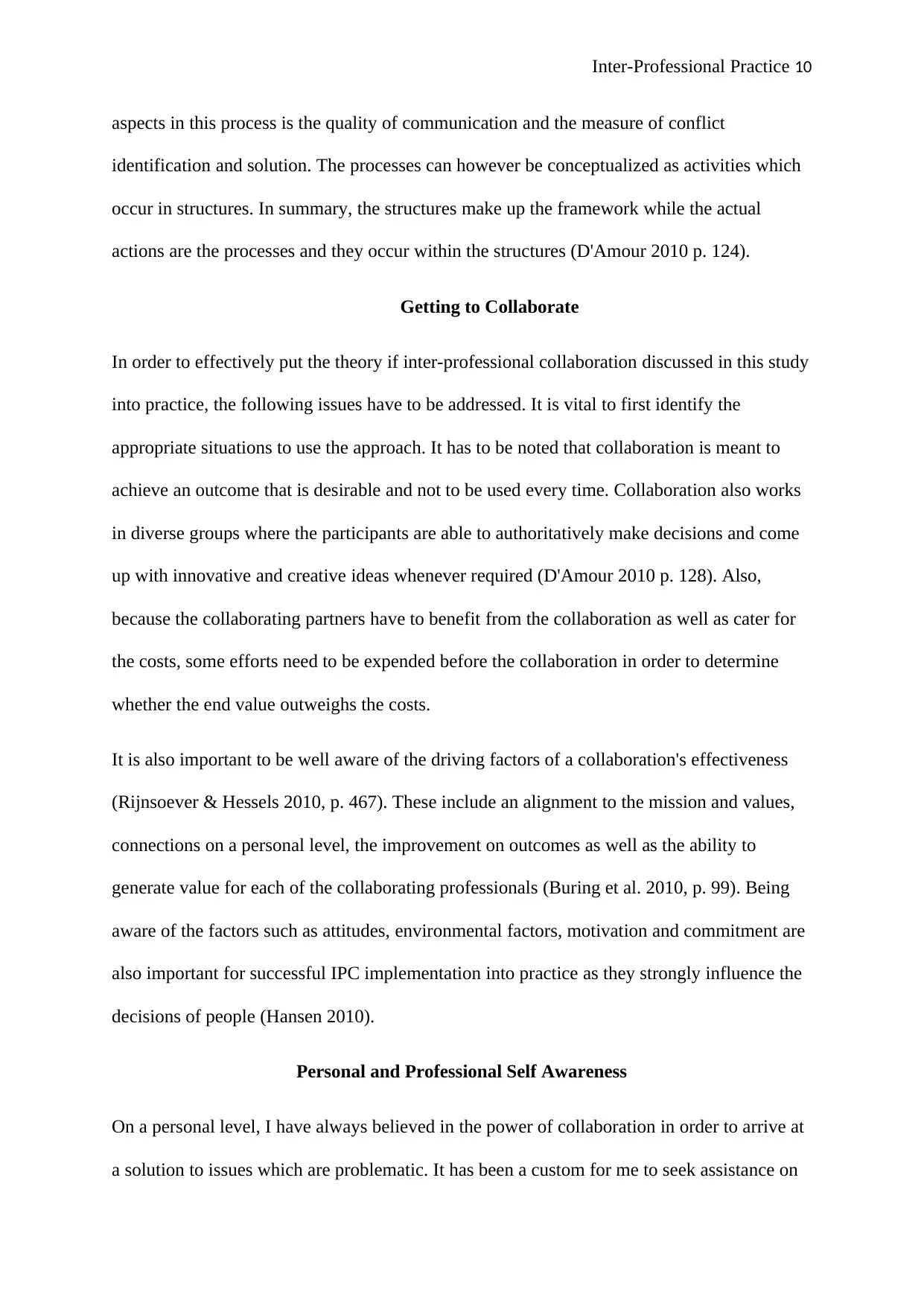
Inter-Professional Practice 10
aspects in this process is the quality of communication and the measure of conflict
identification and solution. The processes can however be conceptualized as activities which
occur in structures. In summary, the structures make up the framework while the actual
actions are the processes and they occur within the structures (D'Amour 2010 p. 124).
Getting to Collaborate
In order to effectively put the theory if inter-professional collaboration discussed in this study
into practice, the following issues have to be addressed. It is vital to first identify the
appropriate situations to use the approach. It has to be noted that collaboration is meant to
achieve an outcome that is desirable and not to be used every time. Collaboration also works
in diverse groups where the participants are able to authoritatively make decisions and come
up with innovative and creative ideas whenever required (D'Amour 2010 p. 128). Also,
because the collaborating partners have to benefit from the collaboration as well as cater for
the costs, some efforts need to be expended before the collaboration in order to determine
whether the end value outweighs the costs.
It is also important to be well aware of the driving factors of a collaboration's effectiveness
(Rijnsoever & Hessels 2010, p. 467). These include an alignment to the mission and values,
connections on a personal level, the improvement on outcomes as well as the ability to
generate value for each of the collaborating professionals (Buring et al. 2010, p. 99). Being
aware of the factors such as attitudes, environmental factors, motivation and commitment are
also important for successful IPC implementation into practice as they strongly influence the
decisions of people (Hansen 2010).
Personal and Professional Self Awareness
On a personal level, I have always believed in the power of collaboration in order to arrive at
a solution to issues which are problematic. It has been a custom for me to seek assistance on
aspects in this process is the quality of communication and the measure of conflict
identification and solution. The processes can however be conceptualized as activities which
occur in structures. In summary, the structures make up the framework while the actual
actions are the processes and they occur within the structures (D'Amour 2010 p. 124).
Getting to Collaborate
In order to effectively put the theory if inter-professional collaboration discussed in this study
into practice, the following issues have to be addressed. It is vital to first identify the
appropriate situations to use the approach. It has to be noted that collaboration is meant to
achieve an outcome that is desirable and not to be used every time. Collaboration also works
in diverse groups where the participants are able to authoritatively make decisions and come
up with innovative and creative ideas whenever required (D'Amour 2010 p. 128). Also,
because the collaborating partners have to benefit from the collaboration as well as cater for
the costs, some efforts need to be expended before the collaboration in order to determine
whether the end value outweighs the costs.
It is also important to be well aware of the driving factors of a collaboration's effectiveness
(Rijnsoever & Hessels 2010, p. 467). These include an alignment to the mission and values,
connections on a personal level, the improvement on outcomes as well as the ability to
generate value for each of the collaborating professionals (Buring et al. 2010, p. 99). Being
aware of the factors such as attitudes, environmental factors, motivation and commitment are
also important for successful IPC implementation into practice as they strongly influence the
decisions of people (Hansen 2010).
Personal and Professional Self Awareness
On a personal level, I have always believed in the power of collaboration in order to arrive at
a solution to issues which are problematic. It has been a custom for me to seek assistance on
Paraphrase This Document
Need a fresh take? Get an instant paraphrase of this document with our AI Paraphraser
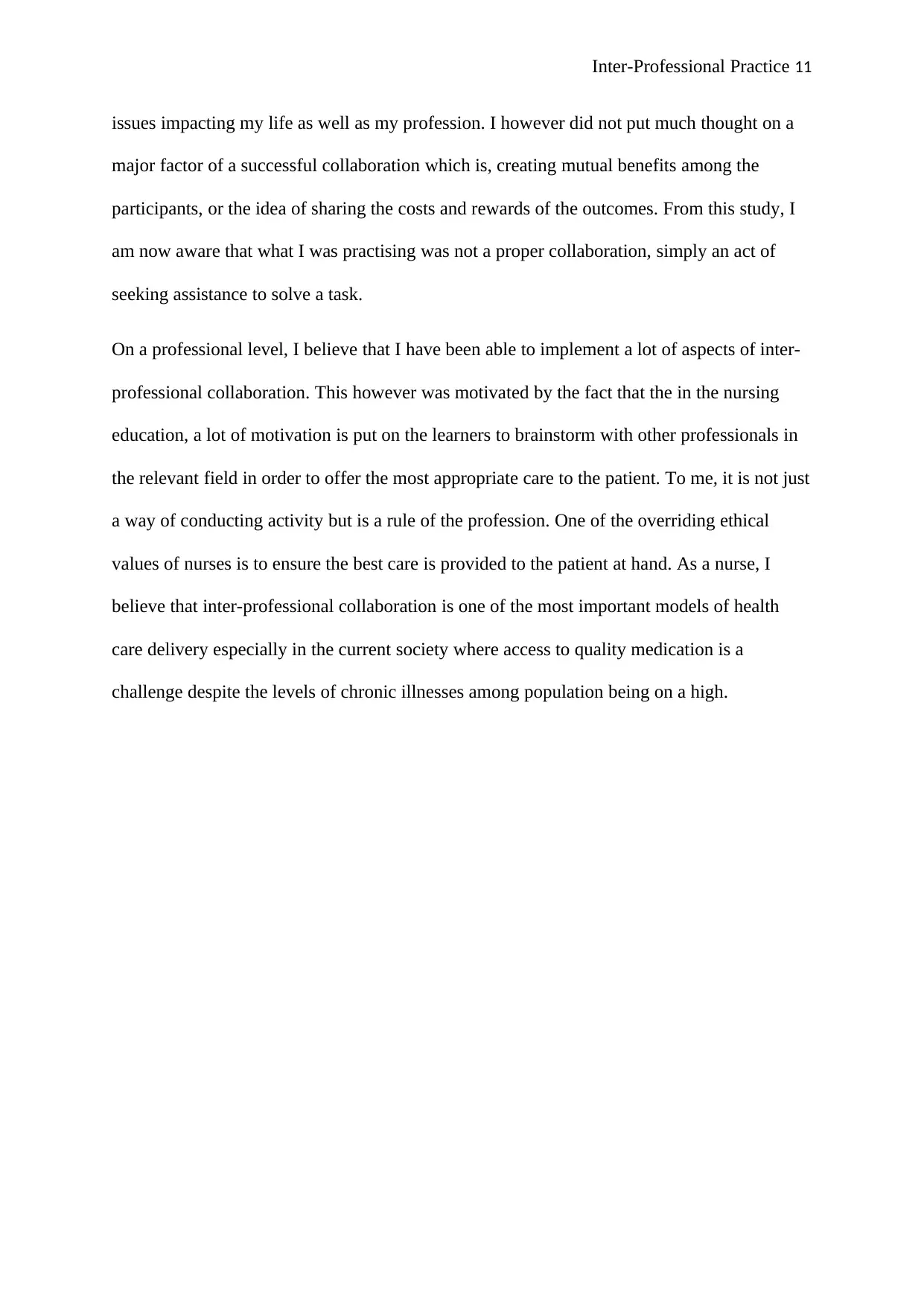
Inter-Professional Practice 11
issues impacting my life as well as my profession. I however did not put much thought on a
major factor of a successful collaboration which is, creating mutual benefits among the
participants, or the idea of sharing the costs and rewards of the outcomes. From this study, I
am now aware that what I was practising was not a proper collaboration, simply an act of
seeking assistance to solve a task.
On a professional level, I believe that I have been able to implement a lot of aspects of inter-
professional collaboration. This however was motivated by the fact that the in the nursing
education, a lot of motivation is put on the learners to brainstorm with other professionals in
the relevant field in order to offer the most appropriate care to the patient. To me, it is not just
a way of conducting activity but is a rule of the profession. One of the overriding ethical
values of nurses is to ensure the best care is provided to the patient at hand. As a nurse, I
believe that inter-professional collaboration is one of the most important models of health
care delivery especially in the current society where access to quality medication is a
challenge despite the levels of chronic illnesses among population being on a high.
issues impacting my life as well as my profession. I however did not put much thought on a
major factor of a successful collaboration which is, creating mutual benefits among the
participants, or the idea of sharing the costs and rewards of the outcomes. From this study, I
am now aware that what I was practising was not a proper collaboration, simply an act of
seeking assistance to solve a task.
On a professional level, I believe that I have been able to implement a lot of aspects of inter-
professional collaboration. This however was motivated by the fact that the in the nursing
education, a lot of motivation is put on the learners to brainstorm with other professionals in
the relevant field in order to offer the most appropriate care to the patient. To me, it is not just
a way of conducting activity but is a rule of the profession. One of the overriding ethical
values of nurses is to ensure the best care is provided to the patient at hand. As a nurse, I
believe that inter-professional collaboration is one of the most important models of health
care delivery especially in the current society where access to quality medication is a
challenge despite the levels of chronic illnesses among population being on a high.
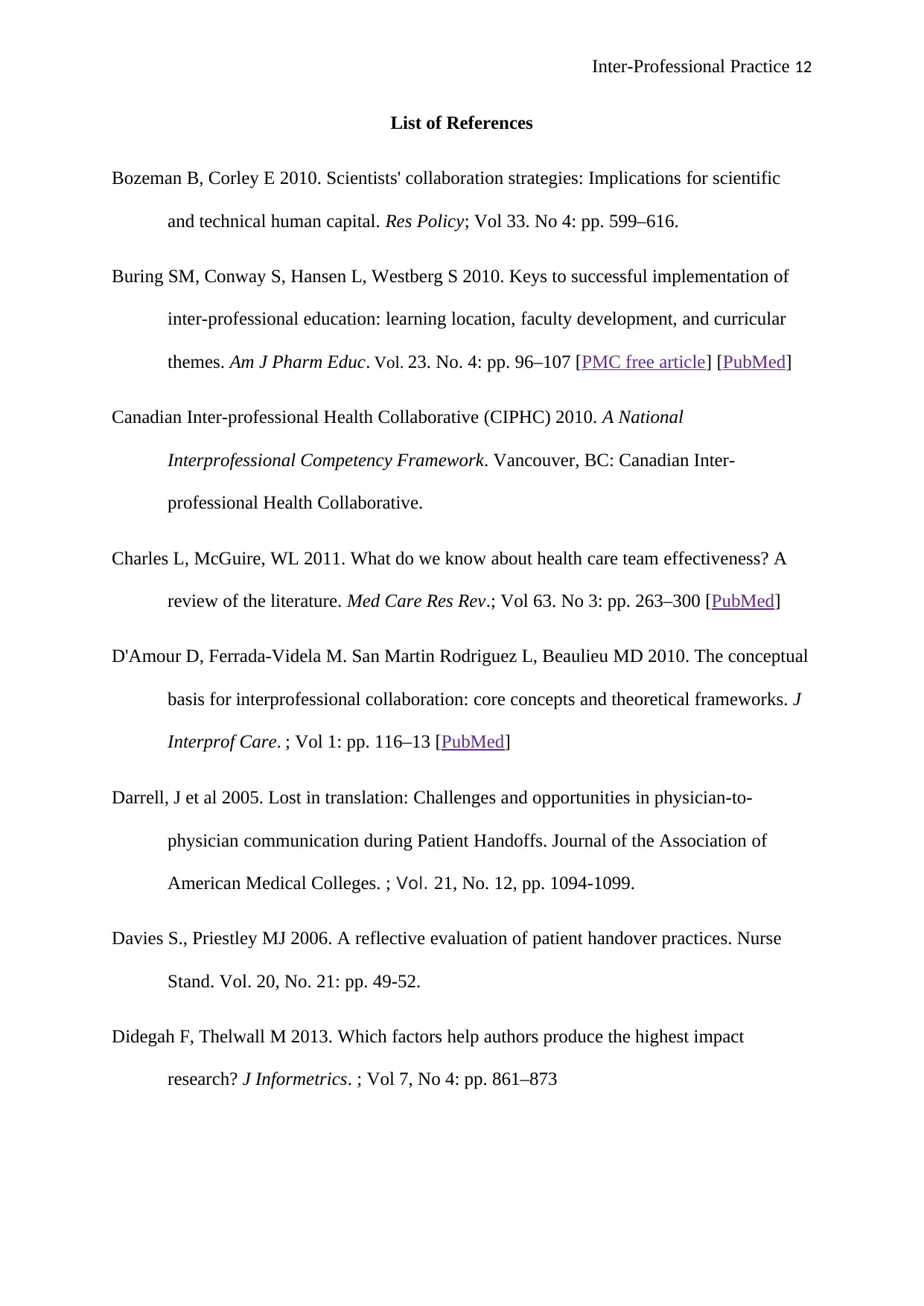
Inter-Professional Practice 12
List of References
Bozeman B, Corley E 2010. Scientists' collaboration strategies: Implications for scientific
and technical human capital. Res Policy; Vol 33. No 4: pp. 599–616.
Buring SM, Conway S, Hansen L, Westberg S 2010. Keys to successful implementation of
inter-professional education: learning location, faculty development, and curricular
themes. Am J Pharm Educ. Vol. 23. No. 4: pp. 96–107 [PMC free article] [PubMed]
Canadian Inter-professional Health Collaborative (CIPHC) 2010. A National
Interprofessional Competency Framework. Vancouver, BC: Canadian Inter-
professional Health Collaborative.
Charles L, McGuire, WL 2011. What do we know about health care team effectiveness? A
review of the literature. Med Care Res Rev.; Vol 63. No 3: pp. 263–300 [PubMed]
D'Amour D, Ferrada-Videla M. San Martin Rodriguez L, Beaulieu MD 2010. The conceptual
basis for interprofessional collaboration: core concepts and theoretical frameworks. J
Interprof Care. ; Vol 1: pp. 116–13 [PubMed]
Darrell, J et al 2005. Lost in translation: Challenges and opportunities in physician-to-
physician communication during Patient Handoffs. Journal of the Association of
American Medical Colleges. ; Vol. 21, No. 12, pp. 1094-1099.
Davies S., Priestley MJ 2006. A reflective evaluation of patient handover practices. Nurse
Stand. Vol. 20, No. 21: pp. 49-52.
Didegah F, Thelwall M 2013. Which factors help authors produce the highest impact
research? J Informetrics. ; Vol 7, No 4: pp. 861–873
List of References
Bozeman B, Corley E 2010. Scientists' collaboration strategies: Implications for scientific
and technical human capital. Res Policy; Vol 33. No 4: pp. 599–616.
Buring SM, Conway S, Hansen L, Westberg S 2010. Keys to successful implementation of
inter-professional education: learning location, faculty development, and curricular
themes. Am J Pharm Educ. Vol. 23. No. 4: pp. 96–107 [PMC free article] [PubMed]
Canadian Inter-professional Health Collaborative (CIPHC) 2010. A National
Interprofessional Competency Framework. Vancouver, BC: Canadian Inter-
professional Health Collaborative.
Charles L, McGuire, WL 2011. What do we know about health care team effectiveness? A
review of the literature. Med Care Res Rev.; Vol 63. No 3: pp. 263–300 [PubMed]
D'Amour D, Ferrada-Videla M. San Martin Rodriguez L, Beaulieu MD 2010. The conceptual
basis for interprofessional collaboration: core concepts and theoretical frameworks. J
Interprof Care. ; Vol 1: pp. 116–13 [PubMed]
Darrell, J et al 2005. Lost in translation: Challenges and opportunities in physician-to-
physician communication during Patient Handoffs. Journal of the Association of
American Medical Colleges. ; Vol. 21, No. 12, pp. 1094-1099.
Davies S., Priestley MJ 2006. A reflective evaluation of patient handover practices. Nurse
Stand. Vol. 20, No. 21: pp. 49-52.
Didegah F, Thelwall M 2013. Which factors help authors produce the highest impact
research? J Informetrics. ; Vol 7, No 4: pp. 861–873
⊘ This is a preview!⊘
Do you want full access?
Subscribe today to unlock all pages.

Trusted by 1+ million students worldwide
1 out of 14
Your All-in-One AI-Powered Toolkit for Academic Success.
+13062052269
info@desklib.com
Available 24*7 on WhatsApp / Email
![[object Object]](/_next/static/media/star-bottom.7253800d.svg)
Unlock your academic potential
Copyright © 2020–2025 A2Z Services. All Rights Reserved. Developed and managed by ZUCOL.